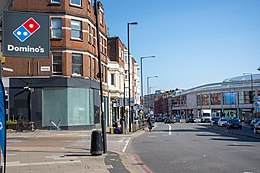
Summary
The Finchley Road bombings occurred on 2 October 1993, when the Provisional Irish Republican Army (IRA) detonated three time bombs on Finchley Road in north London, England. Telephoned warnings were sent six minutes beforehand, at approximately 00:26 UTC, but five people were injured from falling glass as a result of the blasts, and damage was caused to some shops and flats in the surrounding area. The three bombs were planted outside a Domino's Pizza restaurant, a travel agent, and offices of the St. Pancras Building Society. Later, anti-terrorist officers discovered and subsequently safely detonated a fourth bomb in a controlled environment, 1 mile (1.6 km) north of the initial bombings, in Golders Green. Two days later, on 4 October, the IRA detonated four more bombs in north London, two in Tottenham Lane and two more in Archway Road resulting in four injuries.
| 1993 Finchley Road bombings | ||||||||
|---|---|---|---|---|---|---|---|---|
| Part of the Troubles | ||||||||


2km 1.2miles 2
1 | ||||||||
| Location | Finchley Road, Hampstead, London, England | |||||||
| Date | 2 October 1993 00:26 (UTC) | |||||||
| Target | Civilians | |||||||
Attack type | Time bombs | |||||||
| Deaths | 0 | |||||||
| Injured | 5 | |||||||
| Perpetrator | Provisional Irish Republican Army | |||||||
The bombings were branded as "cowardly" by Home Secretary Michael Howard. They were the first IRA bombings in the capital for over five months. Following the bombings, the IRA phoned a Dublin radio station claiming responsibility for the attack.
Background edit
The IRA had carried out many bomb attacks on military and civilian targets in England since the beginning of its campaign in the 1970s. These attacks were carried out with a goal of putting pressure on the British government to withdraw from Northern Ireland.[1] In early 1993, the Northern Ireland peace process was at a delicate stage, with attempts to broker an IRA ceasefire ongoing.[2][3] In 1994, talks were continuing between the two largest Irish nationalists in Northern Ireland; John Hume of the Social Democratic and Labour Party (SDLP), and Gerry Adams of Sinn Féin (SF).[2] There was a high risk of IRA attacks in London in light of the refusal of political talks between the British prime minister, John Major and Sinn Féin, and all British police forces were told to remain prepared for further attacks.[4] In the week after the attack, the Conservative Party was due to host their annual conference.[5] Just over seven months earlier, on 27 February 1993, the IRA detonated a similar bomb in Camden Town, injuring 18 people.[6][4] Prior to the bombings, there had not been any IRA terrorist attacks in London since the 1993 Bishopsgate bombing just over five months earlier.[7][8]
Bombings edit
At 00:20 UTC on 2 October 1993, a telephone warning was sent to a Domino's Pizza on Finchley Road, a major dual carriageway in north London.[9] Six minutes later, at 00:26, one bomb was detonated outside the Domino's Pizza restaurant.[7] At 00:30, another bomb was detonated outside a travel agency and the final bomb was detonated outside the offices of the St. Pancras Building Society.[7][10] The three blasts injured four men and one woman in their twenties, with all injuries caused by from falling glass.[11][12] Police sealed off Finchley Road from Swiss Cottage to West End Lane.[7] A fourth bomb was then found and subsequently defused by anti-terrorism officers a mile upwards of Finchley Road in Golders Green.[13] All of the bombs had been placed in doorways.[13] As a result of the blasts, dozens of shops were damaged.[7] Following the bombing, the IRA phoned a Dublin radio station and claimed responsibility for the attacks.[8]
Investigation and aftermath edit
Home Secretary Michael Howard branded the attacks as "cowardly and contemptible".[8] Chief Superintendent of the Metropolitan Police Tony Buchanan called the attack "murderous", citing that there had been "no opportunity whatever to effect an evacuation". He also condemned the telephone warnings as "totally inadequate" claiming that there was "every possibility a large number of people could've been seriously injured".[10] The five people injured were sent to the Royal Free Hospital, and discharged the next day. The IRA said the bombings had been carried out by a number of active service units.[5] On 2 October, police confirmed the locations of the bombings, and also noted that the effects of the bombings could have been much worse had it not been for a bus arriving early to collect passengers.[10] On 4 October, police issued an artist's impression of a suspect for the blast, whom was said to be wearing a duffel coat-type garment with distinctive yellow bands around it.[14]
See also edit
References edit
- ^ O'Day, Alan (1997). Political Violence in Northern Ireland – Conflict and Conflict Resolution. Greenwood Publishing Group. p. 20. ISBN 978-0-275-95414-7.
- ^ a b Coaffee, Jon (2003). Terrorism, Risk and the City: The Making of a Contemporary Urban Landscape. Ashgate Publishing. p. 94. ISBN 978-0-7546-3555-0.
- ^ Taylor, Peter (1997). Provos The IRA & Sinn Féin. Bloomsbury Publishing. pp. 305–306. ISBN 978-0-7475-3818-9.
- ^ a b De Baróid, Ciarán (2000). Ballymurphy and the Irish War. Pluto Press. p. 325. ISBN 978-0-7453-1509-6.
- ^ a b Bassett, Tony (3 October 1993). "IRA gang gave only six-minute bomb alert". The People. Archived from the original on 6 August 2021. Retrieved 5 June 2021.
- ^ Terry, Kirby; Pithers, Malcolm (28 February 1993). "IRA bomb blast hurts 18 in high street crowded with shoppers". The Independent. London. p. 2. Archived from the original on 6 August 2021. Retrieved 1 June 2021 – via NewsBank.
Eighteen people were injured, two seriously, when an IRA bomb exploded in a crowded north London high street at lunchtime yesterday.
- ^ a b c d e Vincent, John (2 October 1993). "Four injured as bomb blasts hit Finchley Road". The Times. p. 1. Archived from the original on 6 August 2021. Retrieved 21 January 2021 – via The Times Digital Archive.
AT LEAST four people were injured when three bombs exploded early this morning in Finchley Road, near Swiss Cottage, northwest London.
- ^ a b c Kemp, Jackie (3 October 1993). "IRA admits bomb outrage". The Daily Mirror. p. 2. Archived from the original on 6 August 2021. Retrieved 5 June 2021 – via NewsBank.
- ^ Holland, Mary; Mallie, Eamonn (3 October 1993). "Ulster counts cost of piece in raw nerves". The Observer. London. p. 10. Archived from the original on 7 February 2021. Retrieved 21 January 2021 – via Newspapers.com.
- ^ a b c Mason, David (2 October 1993). J Williamson, Richard (ed.). "Six hurt in blasts; Four bombs explode outside London restaurant". Aberdeen Evening Express. p. 2. Retrieved 6 August 2021 – via British Newspaper Archive.
He condemned the telephone warning, which spoke of four devices in Finchley Road, as totally inadequate ... Clearly there was every possibility a large number of people could've been seriously injured
- ^ McKittrick, David (4 October 1993). "IRA says talks could lead to peace". The Independent. Archived from the original on 6 August 2021. Retrieved 1 June 2021 – via NewsBank.
- ^ "Street bombing admitted by IRA". The Times. London. 3 October 1993. ProQuest 318027915. Archived from the original on 6 August 2021. Retrieved 21 January 2021 – via ProQuest.
- ^ a b Mickolus, Edward F.; Simmons, Susan L. (1997). Terrorism, 1992–1995: A Chronology of Events and a Selectively Annotated Bibliography. ABC-CLIO. p. 486. ISBN 978-0-313-30468-2. Archived from the original on 25 March 2021. Retrieved 21 January 2021.
- ^ "Police issue photo of blast suspect". The Press and Journal. 4 October 1993. p. 5 – via British Newspaper Archive.
51°33′55″N 0°11′47″W / 51.56528°N 0.19639°W



